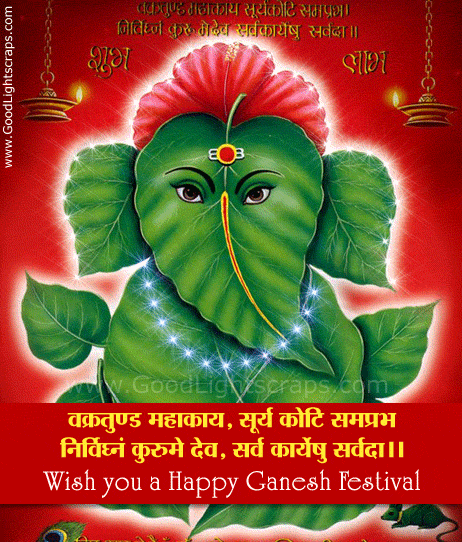Celebration, rituals and tradition

In India
Ganesh Chaturthi starts with the installation of Ganesh statues in colorfully decorated homes and specially erected temporary structures mandapas (pandals) in every locality. The pandals are erected by the people or a specific society or locality or group by collecting monetary contributions. The pandals are decorated specially for the festival, either by using decorative items like flower garlands, lights, etc. or are theme based decorations, which depict religious themes or current events.
The priest, usually clad in red or white dhoti and
uttariyam (Shawl), then symbolically invokes life into the statue by chanting mantras. This ritual is the Pranapratishhtha. After this the ritual called as Shhodashopachara (16 ways of paying tribute) follows. Coconut, jaggery, 21 modakas, 21 durva (trefoil) blades of grass and red flowers are offered. The statue is anointed with red unguent, typically made of kumkum and sandalwood paste. Throughout the ceremony, Vedic hymns from the Rig Veda, the Ganapati Atharva Shirsha Upanishad, and the Ganesha stotra from the Narada Purana are chanted.
Ganesha is worshiped for 10 days from Bhadrapada Shudha Chaturthi to the Ananta Chaturdashi, On the 11th day, the statue is taken through the streets in a procession accompanied with dancing, singing, and fanfare to be immersed in a river or the sea symbolizing a ritual see-off of the Lord in his journey towards his abode in Kailash while taking away with him the misfortunes of his devotees.This is the ritual known as Ganesha Visarjane in Kannada, Ganesh Visarjan in Marathi and Vinayaka Nimarjana or Vinayaka Nimajjanam in Telugu. At individual homes the Visarjan/Nimajjanam is also done on 3rd, 5th or 7th day as per the family tradition. All join in this final procession shouting "Ganapati Bappa Morya, Pudhachya Varshi Laukar ya" (O lord Ganesha, come again early next year) in Maharastra and "Ganesh Maha Raj ki, Jai" (lord Ganesha, victory is yours) in Andhra Pradesh. After the final offering of coconuts, flowers and camphor is made, people carry the idols to the river to immerse it.
The main sweet dish during the festival is the modak (modak in Marathi, modakam/kudumu in Telugu, modaka in Kannada and modagam in Tamil). A modak is a dumpling made from rice flour/wheat flour with a stuffing of fresh or dry-grated coconut, jaggery, dry fruits and some other condiments. It is either steam-cooked or fried. Another popular sweet dish is the karanji (karjikai in Kannada) which is similar to the modak in composition and taste but has a semicircular shape.

In Andhra, kudumu (rice flour dumplings stuffed with coconut and jaggery mixture), Vundrallu (steamed coarsely grounded rice flour balls), Panakam (jaggery, black pepper and cardamom flavored drink), Vadapappu (soaked and moong lentils), Chalividi (cooked rice flour and jaggery mixture), etc., are offered to Ganesha along with Modakams. These offerings to god are called Naivedyam in Telugu.
In Andhra, Clay Ganesh (Matti Vinayakudu in Telugu) and Turmeric Ganesh (Siddhi Vinayakudu in Telugu) is usually worshiped at homes along with plaster of paris Ganesha.
Public celebrations of the festival are hugely popular, with local communities (mandalas) vying with each other to put up the biggest statue and the best pandal. The festival is also the time for cultural activities like singing and theater performances, orchestra and community activities like free medical checkup, blood donation camps, charity for the poor, etc.
Today, the Ganesh Festival is not only a popular festival, it has become a very critical and important economic activity for Mumbai,Hyderabad, Vishakhapatnam, Bangalore and Chennai. Many artists, industries, and businesses survive on this mega-event. Ganesh Festival also provides a stage for budding artists to present their art to the public. In Maharashtra, not only Hindus but many other religions also participate in the celebration like Muslims, Jains, Christian and others.
This festival managed to re-establish the unity among the Indians during British Era.

Edited by manesha76 - 11 years ago

























comment:
p_commentcount